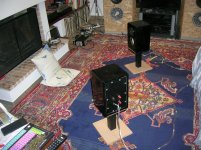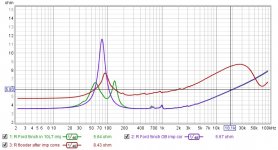I’ve done impedance sweeps on loudspeaker alone and on loudspeaker plus the cables.How do we get on from here ?
I’ll see what I can do by subtracting the sweeps in Excel (I need some time).
Then IMD tests
And center image listening test.
On this, I followed Mark’s recommendation Zip cord for speaker test
In my case it helped a lot by reducing room influence due to close speaker positioning. Thank you Mark!
Please let’s all try to keep this thread focused on the specific technical issues
George
Attachments
How do we get on from here ?
Hans
Superbly of course..
In examination of George's impedance plot for his speaker, it is of note that the midrange has a lot of higher impedance areas. Pano's OTOH, has a distinct 6-8 ohm valley in the band of hearing where we are sensitive to ITD.
The effect being tested for is a 10-20 uSec delay in the midrange caused by that very low impedance (w/r to the wires).
It is certainly a thought that the speaker impedance profile affects whether this happens at an audible level or not, as a speaker with a dead flat impedance through the audio band will not possibly have settling time changes that could rise to audible levels.
It is with sadness that I have to say something that really causes me to clench my teeth.....
If this speaker wire impedance/load impedance variation is actually viable, that puts me in the position of wondering if Joe Rasmussen has accidentally backed into a solution to the wire issue I describe...
I really hated typing that, I need a martini!!!
Of course, the results are not in yet, so clamping onto that possibility is premature...
jn
Last edited:
George,
My apologies.
My intent is one of collaboration amongst many very intelligent and knowledgeable people..it is not about me..
Thank you for your time and effort...
John
ps..your mention of keeping this thread on a technical line is very much appreciated. thank you.
My apologies.
My intent is one of collaboration amongst many very intelligent and knowledgeable people..it is not about me..
Thank you for your time and effort...
John
ps..your mention of keeping this thread on a technical line is very much appreciated. thank you.
Last edited:
Superbly of course..
In examination of George's impedance plot for his speaker, it is of note that the midrange has a lot of higher impedance areas. Pano's OTOH, has a distinct 6-8 ohm valley in the band of hearing where we are sensitive to ITD.
The effect being tested for is a 10-20 uSec delay in the midrange caused by that very low impedance (w/r to the wires).
It is certainly a thought that the speaker impedance profile affects whether this happens at an audible level or not, as a speaker with a dead flat impedance through the audio band will not possibly have settling time changes that could rise to audible levels.
It is with sadness that I have to say something that really causes me to clench my teeth.....
If this speaker wire impedance/load impedance variation is actually viable, that puts me in the position of wondering if Joe Rasmussen has accidentally backed into a solution to the wire issue I describe...
I really hated typing that, I need a martini!!!
Of course, the results are not in yet, so clamping onto that possibility is premature...
jn
Are you sure that 10-20us delay is for sound coming from 2 speakers, or are those numbers for headphones? We didn't evolve to locate phantom center images.
There is a distinction between lateralization and localization.
I agree, it is an interesting distinction as laterlization involves no crosstalk.
The distinction is difficult.
Hopefully, we can understand the distinctions as well as the similarities.
jn
ps..it seems the numbers (2-5 useC) do indeed cross the lateral...locall... barrier.
jn
I agree, it is an interesting distinction as laterlization involves no crosstalk.
The distinction is difficult.
Hopefully, we can understand the distinctions as well as the similarities.
jn
ps..it seems the numbers (2-5 useC) do indeed cross the lateral...locall... barrier.
jn
Last edited:
10 us (at least) is an often confirmed number in localization experiments (minimum audible angle) but of course, holds true only for the frontal medium plane.
Time-of-arrival-stereophony is based on the arrival differences; fairly linear for small to medium angles.
Time-of-arrival-stereophony is based on the arrival differences; fairly linear for small to medium angles.
Last edited:
To be fair, we have to state, that Kunchur's results (partly) could be triggered by the level difference, but that we don't know if that is the reason.
We have discussed the "timing" topic quite often in the past and - as said before - the 10us number does not depend on Kunchur's experiments.
There were some experiments done in the past 40 - 50 years and the results provided some corrobation for the hypothesis that (some) humans might be able to detect smaller differences.
We have discussed the "timing" topic quite often in the past and - as said before - the 10us number does not depend on Kunchur's experiments.
There were some experiments done in the past 40 - 50 years and the results provided some corrobation for the hypothesis that (some) humans might be able to detect smaller differences.
To be fair, we have to state, that Kunchur's results (partly) could be triggered by the level difference, but that we don't know if that is the reason.
Not going into detail, but it was without a doubt the reason and this was clearly communicated with Kunchur.
But I can live with the 10usec that you mention.
Hans
Not going into detail, but it was without a doubt the reason and this was clearly communicated with Kunchur.
But I can live with the 10usec that you mention.
Hans
John,
Hopefully you don’t refer to Kunchur with the 2-5 usec because that was erroneous.
All he proved in his test was that our threshold for discriminating level differences was ca. 0.7 dB
Hans
No, not Kuncher.
George,
Purple looks best as it has a LF impedance peak and a long valley in the human ITD sensitive range.
Choose a freq at that peak and one at the lowest point in the valley for IMD.
John
All he proved in his test was that our threshold for discriminating level differences was ca. 0.7 dB
A technical point if I may. Maybe better to say, "...All he found evidence for was that our threshold..."
To be fair, we have to state, that Kunchur's results (partly) could be triggered by the level difference, but that we don't know if that is the reason.
Not going into detail, but it was without a doubt the reason and this was clearly communicated with Kunchur.
But I can live with the 10usec that you mention.
Hans
Not goint into detail either, of course the level difference existed but (matter of logic), we don't know if the participants were detecting the level difference and/or the time difference.
So only the conclusion is justified that the experiment(s) were not rigorous enough to test only the effect under test.
A technical point if I may. Maybe better to say, "...All he found evidence for was that our threshold..."
In Holland we call this kind of subtle differences “looking for nails at low tide”
Hans
No.John,
You mentioned Joe Rasmussen, creator of this Elsinore speaker.
Did you ever have the opportunity to listen to these speakers ?
Hans
But it dawned on me that I have described an effect that occurs naturally when the line and load impedance are badly mismatched. And because of large variations in load impedance at various frequencies, the effect becomes frequency dependent.
So I chose a wire configuration which brings the line impedance down sufficiently that the effect falls below a microsecond or so, below human abilities to discern.
Joe OTOH, tries to make the end composite load constant impedance. This will still be line to load ratio sensitive, but the settling speed will remain consistent through the audio band. Who cares if all the content is delayed by the same amount frequency independent.
His explanation is of course, entirely useless, but then again, he doesn't understand T-line theory sufficiently to figure it out, so he could never have gotten to this point.
I, OTOH, will not hold back understandings or thinkings just because it might bolster someone who is not popular..
ps..that said, my hypothesis has not been confirmed by verifiable, repeatable tests as of yet, so it is still a hypothesis.
John
pps. at this time, I have broached this analysis with the physicists at work, as they have an unexplained 80uSec latency from 180 independent power supplies to the magnetic fields generated in magnets roughly 60 meters away. The cables are twisted pair #14, I am proposing the use of 4 or 5 coaxial 50 ohm cables in parallel as a first pass test on one unit to see how much the latency drops. A trivial experiment to set up on a maintenence day, and one which does not disrupt machine operation. Should it provide a nice benefit, the PhD physicist student will have a wonderful paper to publish and present at an accelerator conference, and I will be busy installing 900 additional cables up to 60 meters long.... It is also possible that most of it is being caused by eddy current effects of the magfield trying to go through a 1.5mm wall of conductive material, stainless IIRC.
Last edited:
- Home
- General Interest
- Everything Else
- Zip cord for speaker test

